
What Do We Mean When We Call a Character a “Monster”?
For Jess Zimmerman, One Reader’s Villain is Another’s Hero
Many years ago, before I knew it was a cliche to get into a fight with a man on the internet about Lolita, I got into a fight with a man on the internet about Lolita. He was arguing the position that Humbert Humbert, literature’s most high-gloss pedophile, was simply heeding any red-blooded straight man’s desire for preadolescent girls. I was arguing the position that he was being a sucker, and also, yuck.
I definitely won, though I’m sure he didn’t notice; anyone who was going to graciously admit defeat in a conversation like this probably wouldn’t be defending statutory rape in the first place. What I remember, unaccountably, more than 20 years later, is my coup de grace: “If you think Humbert Humbert is too reasonable or too charming to be a monster, you’re right on one level. But you’re completely missing the other level, which is the one where he is a monster.”
This is the genius of Lolita, the reason we’re still using it as a literary touchpoint more than 65 years after its publication, even though it is gross. (Just last year, the book Lolita in the Afterlife collected essays on the novel by writers like Alexander Chee, Roxane Gay, Lauren Groff, and Ian Frazier.) Though Humbert Humbert isn’t my favorite Nabokov unreliable narrator (Charles Kinbote hive rise up), the book is brilliantly double-tongued, letting Humbert weave his jeweled nets of language but still allowing you to peek through the holes and see the horrors he commits. That’s what earns him the top shelf in a bookcase full of indelible literary sociopaths: Becky Sharp, Tom Ripley, Merricat Blackwood, Richard III.
My own interests, which I wrote about in my book Women and Other Monsters, are more about rehabilitating the traits that women and feminized people have been made to feel are monstrous: ugliness, anger, intellect, ambition. Most of these traits are neutral, even admirable in and of themselves—normal at worst—but they have historically been rendered freakish by people with a vested interest in keeping women small; by interrogating the figures of feminized monsters of myth, like the Harpies and the Sphinx, I try to make the case that one man’s monster is another woman’s hero. But there’s also something undeniably compelling about people (fictional people, anyway!) who truly cross the line into the morally grotesque—especially when they allow that split consciousness, seeing their objective repugnance and their internal sense of righteousness overlaid.
In fact, these two phenomena—rejecting the idea that it’s fundamentally monstrous to overstep unjust constraints, and being captivated by people who blithely steamroll social and moral norms—are probably connected. Though the monsters of literature are sometimes beholden, even prisoner, to their own idiosyncratic rules, they are—or at any rate, they seem to be—utterly free of the manners and mores that keep the rest of us locked within limits. Spend enough time in their company, and you see that this freedom is illusory.
But to watch someone flout the rules is to imagine, however briefly, that rules are not immutable: that they were made for reasons, and that the reasons may not be pure. Most of the time that dream is punctured: no, the rules are there to preserve our humanity and our ability to live in a society, they exist for a reason after all. But once in a while, that glimpse beyond constraints is the first step of a necessary undoing.
To feed your own reevaluation, here are nine recent, recent-ish, and forthcoming books whose central characters range from “deeply damaged” to “actively criminal” on the scale of moral monstrosity.
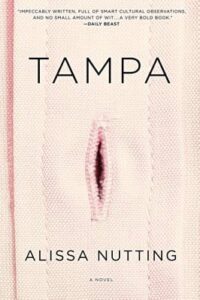
Alissa Nutting, Tampa
(Ecco Press)
“Bad news, unfortunately Tampa is brilliant,” I texted my friends when I read it. “I’m hating every second. She’s a genius.” God knows no one asked for a gender-swapped Lolita about a howling void of a woman who’s so obsessed with the idea of molesting teenage boys that she becomes an eighth-grade English teacher so she can effectively target her victims—and it certainly is a deeply unpleasant read. The narrator, Celeste, never apologizes for or excuses her proclivities or her actions; she doesn’t even justify herself, seeming not to register that she should feel bad in the first place. She revels not only in her statutory gratification but in the trauma she’s inflicting—she imagines her young targets ruined in the future by the time they spent with her.
But she’s deeply magnetic, a moral emptiness so sucking it becomes a black hole. And god, the language of the thing—her outlandish fantasies, her ice-blooded strategizing, her waspish internal monologue—is just so squirmingly funny. I wasn’t sure what to make of the title at first (my Floridian husband: “Does it take place in Tampa?” Me: “Oh! I guess so? She’s always talking about the heat but I thought she was just being… visceral”), but on reflection, what else could you call it, and where else could it be? Nasty, overheated, blankly unapologetic, bone-deep twisted, hilarious if it’s satire but you’re not sure what it’s satirizing, and wall-to-wall with illegal shit: this might just be Florida in novel form.

Chelsea G. Summers, A Certain Hunger
(Unnamed Press)
Dorothy, the food-writer narrator of A Certain Hunger, isn’t precisely likable; she’s pretentious, superior, and not as clever as she thinks. (Sample sentence: “The food was excellent, especially its duck liver toast—unctuous as a Vegas emcee, salty as a vaudeville comedian—and its steak and kidney pie—tender as a love song, rich as Warren G. Harding.”) Oh, and she’s also a cannibalistic murderer. If American Psycho were taking aim at bougie pseudointellectuals instead of hollowed-out Wall Street guys, or if Hannibal Lecter had a niece who went to Brown, it might read this way.
Still, insufferable as she is, Dorothy represents an outsize voraciousness that is, in its way, courageous; women are not supposed to admit to hunger, let alone luxuriate in food, sex, and taboo. You know from the beginning that she’ll be caught, since she’s writing from prison, and so it feels safe to admire certain aspects of her story—not the crimes per se, but the unapologetic appetites they represent. Yes, Dorothy will intermittently lecture the reader about the cultural significance of cannibalism, the history of the meat cleaver, or the technical definition of “serial killer,” but isn’t that simply another way she fearlessly inhabits a space of desire that women are supposed to be too timid to colonize? This is a woman not afraid to eat, to fuck, or to mansplain.
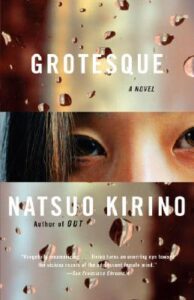
Natsuo Kirino, tr. by Rebecca Copeland, Grotesque: A Thriller
(Vintage)
Through narration, journals, and court statements, Grotesque takes us inside the minds of four monsters: a misanthrope, a nymphomaniac, a crackpot, and a murderer. Or, depending on your perspective, it lets us become intimately acquainted with deeply human emotions like bitterness, envy, hubris, loneliness, desire, and shame. “A monster is a person with something twisted inside, something that grows and grows until it looms all out of proportion,” writes the nameless narrator, a cold-hearted woman driven by envy and spite. Her unearthly beautiful sister Yuriko is a monster to her; so is her brilliant, driven high school classmate Mitsuru, and her unbrilliant but desperately hard-working classmate Kazue. So is the man who murdered Kazue and Yuriko, now decades out of school and working as sex workers. So is she. (Especially in the original novel—the translated version underplays the depth of her fall.) Yet as the book zooms in on these twisted, looming things, they start to feel less like the grotesqueries implied by the title, and more like simple metastasized sadness and need.

Victor LaValle, The Ballad of Black Tom
(Tor Books)
Despite growing public knowledge that H.P. Lovecraft was a virulent racist, the Cthulhu mythos refuses to die—partly because that is not dead which can eternal lie, but mostly because the idea of an unimaginably old, inconceivably dreadful malign power hovering just outside of comprehension is so damn multi-purpose. For Lovecraft, the looming threat was stuff like “immigration” and “interracial marriage,” because he was that kind of guy. But for the writers of color who have reclaimed and reinscribed cosmic horror in recent years—including N.K. Jemisin, Cassandra Khaw, and Victor LaValle—this sense of existential foreboding is a rich loam that can grow something much more nourishing. In Jemisin’s The City We Became, for instance, the Elder God figure is an avatar of gentrification. And in LaValle’s novella The Ballad of Black Tom, an inversion of “The Horror at Red Hook” (an especially racist story, even for Lovecraft), Cthulhu represents a blessed cosmic indifference, deadly but impartial, towards which the central character is pushed by human bigotry and cruelty.
“Every time I was around them, they acted like I was a monster. So I said goddamit, I’ll be the worst monster you ever saw,” says Black Tom, once a frightened and much-wronged young man and now something greater and worse. This list wouldn’t be any fun without a literal monster or two, and here’s a fantasy creature who’s also lush with metaphorical commentary on the real world.

Helene Tursten, tr. by Marlaine Delargy, An Elderly Lady Is Up to No Good
(Soho Crime)
Imagine if the classic, somewhat corny poem about aging ungracefully went “When I am an old woman I shall wear purple / With a red hat that’s been dyed in the blood of my enemies,” and you’ll start to get a sense of An Elderly Lady Is Up to No Good. Maud, the viewpoint character for four of the five stories in this small book, spent half her life caring for a mentally ailing sister; now, nearly 90 and blessed with a rent-free apartment, she feels that she’s earned the right to travel widely, eat and drink what she wants, and be mostly left alone. Anyone would sympathize, especially anyone who’s been a caretaker or dreamed of a comfortable old age—so when Maud starts expertly bumping off anyone who gets even slightly in her way, and then flagrantly taking advantage of people’s tendency to ignore and belittle old women to keep herself out of suspicion, you’re fully on her side. This is as endearing as a book about a murderer can be, especially when it closely splices descriptions of Maud’s cozy snacks with her calculated crimes: “Later, she enjoyed a delicious chicken salad on the balcony. She treated herself to a glass of port to accompany the ice cream, and she topped it off with a cup of coffee. If it hadn’t been for the dead body in the gentleman’s room, it would have been the perfect conclusion to a lovely summer’s day.”
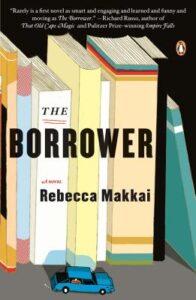
Rebecca Makkai, The Borrower
(Penguin Group)
Lucy, a 26-year-old librarian, is far from amoral. If anything, she’s suffering from too much principle. When she skips town with a ten-year-old library patron, it’s only out of concern for the boy, who is being stifled by deeply religious parents who send him to a gay conversion weekend Bible school and insist he only read books with “the breath of God” in them. The reader is presented with an elaborate bouquet of excuses, which the bleeding-hearted among us are inclined to accept with open arms: But he ran away first. But he wouldn’t tell her where he lived. But he was so unhappy at home. But his parents were harming him. But he said that if she called anyone he would tell them she kidnapped him. But… also, she did kidnap him.
Lucy is a curious kind of monster, if she’s a monster at all. Are her actions heroic? Illegal? Naive? Some combination of the three? (Actually, it’s definitely some combination of the three, but in what proportion is the question.) Many readers will be sympathetic to her urge to protect a child in psychological danger, even to the point of dangerously overstepping her bounds. It’s interesting, though, to see how similar her self-justifications sound to some of the criminal psychopaths on this list. Does the difference between a righteous crime and a monstrous one lie in how much you agree with the perpetrator’s personal code?
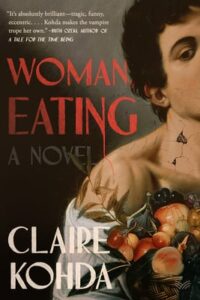
Claire Kohda, Woman, Eating: A Literary Vampire Novel
(Harper Via)
Okay, one more literal monster. Claire Kohda’s forthcoming debut may be the first novel that dares to ask: What happens when a vampire has a quarter-life crisis? (If you’re dead and immortal, it’s not clear how you’re supposed to know when to have a quarter-life crisis anyway, but we’ll set that question aside.) Kohda’s narrator Lydia is trying to figure out how to live alone for the first time, with the host of familiar problems that entails. She’s struggling to develop her own identity apart from a mother who’s suffering premature dementia; wrestling with a cultural heritage passed down from two immigrant parents, one of whom she never knew; interrogating her relationship to creative work now that she’s graduated from art school; navigating a surreally unpleasant internship with a handsy boss; possibly having a crush on a man in her block of studios; and, of course, trying to figure out how to feed herself.
This last one is especially challenging, because her mother was always the one to get the animal blood, which is all they can eat, unless they give in and eat humans. If I’m making it sound funny, that’s because there’s something inherently funny in the idea of a Millennial vampire, but in Kohda’s hands, this slightly absurd setup becomes saturated with lyricism. Lydia is taciturn, bruised, detached from the people around her—but her internal reflections on food, art, family, and the clairvoyant sense of connection she gets from drinking blood are larger and brighter than life.
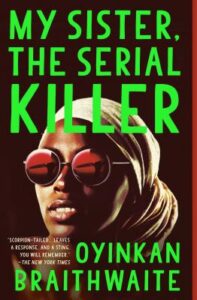
Oyinkan Braithwaite, My Sister, the Serial Killer
(Anchor Books)
The beautiful, heartless Ayoola is not the narrator or even the viewpoint character of Braithwaite’s brisk, funny debut, but she’s the pole around which it orbits—”it” meaning the novel, but also her long-suffering sister Korede’s entire life. The best nurse at the Lagos hospital where she works, Korede is competent, compassionate, and cool-headed, all of which come in handy when she keeps having to help Ayoola dispose of the dead bodies of her suitors. Though the reader never really gets a glimpse of what’s going on in Ayoola’s head when she does her murders (not a lot, it seems!), we do get to watch the otherwise principled Korede—who at one point dismisses her aunt’s advice by telling us “I know better than to take life directions from someone without a moral compass”—justify carving out a hole in her ethics when loyalty to her sister demands it, even when Ayoola’s capacity for capricious violence starts to threaten someone else Korede cares for. It’s a commentary on what we’ll let people get away with, and who winds up facing the consequences (“That’s the way it’s always been,” writes Korede; “Ayoola would break a glass, and I would receive the blame for giving her the drink. Ayoola would fail a class, and I would be blamed for not coaching her”). But it’s also just kind of a romp.
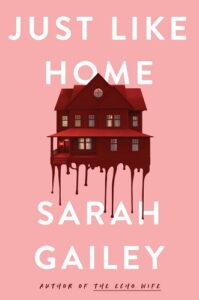
Sarah Gailey, Just Like Home
(Tor Books)
Are you getting a bit sick of serial killers? Here’s a twist: the serial killer in Gailey’s vivid, spooky forthcoming novel is also the kindest and noblest character in the book. Of course, this may be because we’re seeing him through the memory of his adoring adult daughter Vera, returning home 17 years after her late father, notorious murderer Francis Crowder, was captured and imprisoned. Vera’s mother is dying, which is the only reason she’s allowed Vera to return to the house, a sort of living monument that is both metaphorically haunted by Francis’s crimes and, it becomes increasingly clear, more literally haunted by—something. The many men he killed there? The imaginary friend of Vera’s childhood? Francis himself? The more we learn about Vera, her beloved father, her controlling and hateful mother, the paying “guest” who’s come to soak up ghoulish inspiration, and whatever is lurking inside the Crowder House, the harder it becomes to pinpoint what “evil” really means. Like all the best gothic novels, this one is atmospheric, at times hallucinatory, and absolutely oozing with menace; like all the best literary fiction, it resists easy judgments. The true monster could be anyone here, or no one, or something larger than all of them.
Jess Zimmerman
Jess Zimmerman is an editor at Quirk Books and the author of Women and Other Monsters and Basic Witches (with Jaya Saxena).












